As a homesteader, making your own alcohol is important as it turns waste fruits and sugars you may have into alcohol – allowing you to be more self-sufficient.
This article details how to throw a simple distillation system together, out of things you have lying around in your shed, or can find in a scrap yard. This project takes about two hours in total to assemble. The idea here is that we are not aiming to make something beautiful – we are aiming to make a simple, quick to build system that uses cheap, locally available wood waste from our homestead as fuel.
Materials Needed For The Distiller
- Old copper water boiler/geyser tank. Old domestic geysers tended to be made out of copper. These make the perfect boiler for distilling.
- An approximately 2m length of 5/8” (15mm) copper pipe.
- A slightly shorter piece of ¾” (19mm) copper pipe.
- Two ¾” (19mm) straight 5/8” (15mm) reducer tees.
- Two ¾” (19mm) straight 5/8” reducers.
- Assorted compression fitting and elbows to put on each end, to connect to the tank. This will depend on what the size pipes on your boiler are.
- Inlet tap. Outlet tap.
- Assorted bricks and slabs of concrete to make your fireplace.
- Hose pipes for connecting water to cooling system.
This is my system. A 150 L copper boiler, and a simple condenser made from some old copper pipes I had in my shed. Note that the copper pipes are not even cleaned. Later on, we clean the inside of the system with vinegar, but there is no real need to clean the outside – it is not in contact with your liquids, and cleaning just wastes time. It will be burn black with soot in no time.
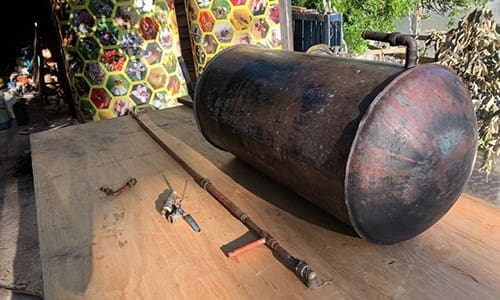
The Build Of The Moonshine Distiller
To make a simple Liebig condenser we use a ¾” (19mm) straight 5/8” (15mm) reducing tee and a ¾” (19mm) straight 5/8” (15mm) reducer. As you can see here, this will allow us to pass cool water through the ¾” (19mm) pipe so it keeps the 5/8” (15mm) pipe running through it cool. You may need to use a file to remove any stops in the inside of the 5/8” (15mm) reducer, so that you can place the pipe right through it. I just glue the fittings with silicon sealant, making it easy to use the system for other things later if necessary. If you wish, you can braze/solder the fittings, but this takes time and effort, and you never know whether lead free solder is really lead free these days.
The completed Tee and reducer. Note the compression fitting on the ¾” (19mm) pipe just happened to be there as it was a scrap pipe.
Related: How to Build a Water Purification System in 10 Minutes

The filling tap. Make sure this is closed when you start the fire!!
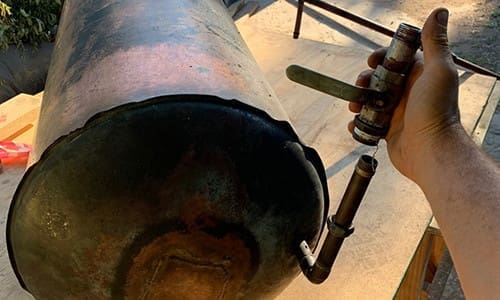
The drain tap. I connect this system to my irrigation system and when I am finished a distillation, I let it run the vinasse into my irrigation system. Diluted vinasse is a great fertilizer. Make sure that the dilution rate is at least 1 liter vinasse to 20 liters irrigation water.
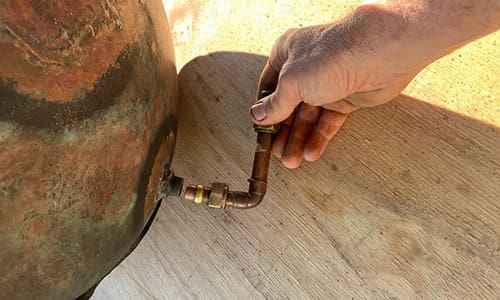
Place the boiler on the ground to get an idea of the dimensions of the fireplace.
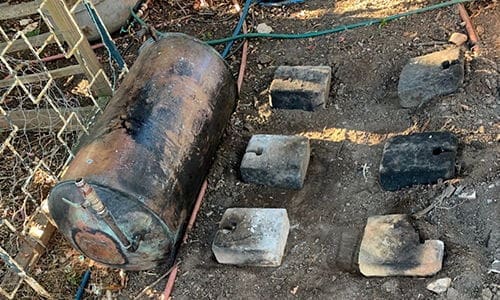
Some bricks on the ground and then concrete slabs gives a good air flow to maintain the fire.
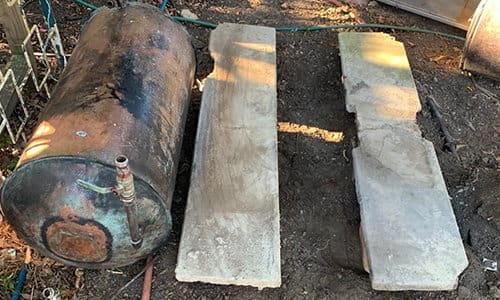
These pieces of waste concrete created an angle.
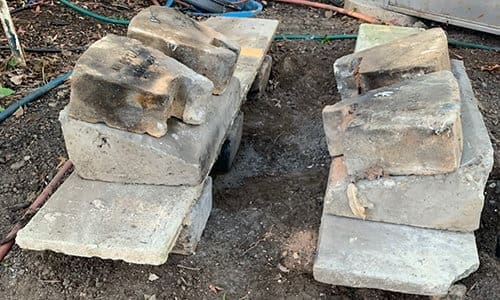
The completed distiller being inspected by “the boss” for accuracy.

The distiller with the coolant reservoir in the background. I use a small fountain pump to circulate water from the small dam to the condenser, and back to the dam. You can use any source of cold water to keep the condenser temperature low.

I start the wood fire with a propane burner for speed.
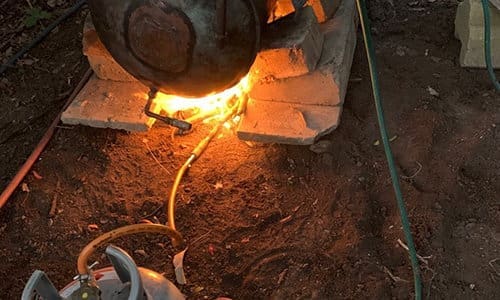
For the first distillation, it is a good idea to make up a dilute vinegar solution – I use some old vinegar I made from plums, but a 5-liter bottle of cheap white vinegar, mixed into twenty liters of water, will work. Boil this and let it run through the distiller. You will see that the collected condensate is a greenish color, as the vinegar strips all the copper oxides out of the pipe, as well as other gunk that may have been in there.
This is the condensate collected after boiling the vinegar in the boiler. I dispose of this by placing it in an area where I am not worried about copper pollution in my food or water. After you have cleaned the boiler and condenser on the inside using this solution, you are ready to distill.

Typically, I charge the tank with 100 L of wash. To warm this up, you can place old bad wood – rotten, quick burning timber that would not go in your fireplace is ideal. You don’t want to use good wood, as you just need to get the temperature up to the point where alcohol comes off, and from here, you want to be able to control the fire with small sticks so as not to overheat your system.

Small sticks like these are ideal for regulating temperature once alcohol begins to distill. These sticks can be placed under the boiler, and you can throw water into the fire to cool it, if the temperature gets too high.
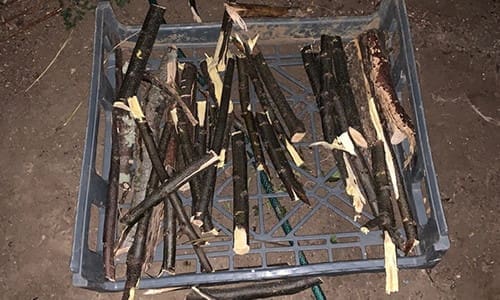
Once the distillation begins, it is good practice to keep the first few liters of alcohol that come out aside as these contain the so called “heads” methanol, ketones and bad chemicals produced during cellular metabolism that are not good to drink or use. I typically keep 2.5 liters aside as heads, and use this alcohol for cleaning windows, and lighting fires.

Once you have removed the heads, the alcohol that collects is your good alcohol, and I typically keep this in 2.5 L bottles. You can vary the flavor profile of your alcohol by varying the temperature of the fire. The fact that the boiler is a copper drum, and the top of the drum is in contact with air, allows you to regulate the heat and flavor condensate that comes out of distiller quite accurately. In a way, it is a primitive alembic that happens by accident. You will note I place the distiller at a slight angle to magnify this effect.
When distilling a calvados, or apple brandy, as an example, if you start with a slow fire, and keep the rate of alcohol distilling as a slow trickle, the first ten or so liters of alcohol will come out with a very strong apple nose that is very pleasant. If you run the fire hotter, this is lost.
With a rum, made from molasses, a hotter fire will bring some of the rum notes through in the early alcohol coming out, and this can make for quite a pleasant rum. Typically, rum flavors are partially caused by Fusel oils – and with a hot fire you can get some of these to go through the condenser.
Safety Note
Alcohol is highly flammable, but easy to extinguish. Dilute alcohol does not burn – hence always have a few buckets of water handy. If you feel suddenly very hot – dump a bucket of water over yourself. Alcohol burns with a nearly invisible flame during the day. It sounds funny, but when you are the one doing the distillers dance, jumping around, it hurts quite a bit and is not funny at all.
You may also like:
Easy to Build Root Cellar in Your Own Back Yard (Video)
Best Dog Breeds For Homesteaders
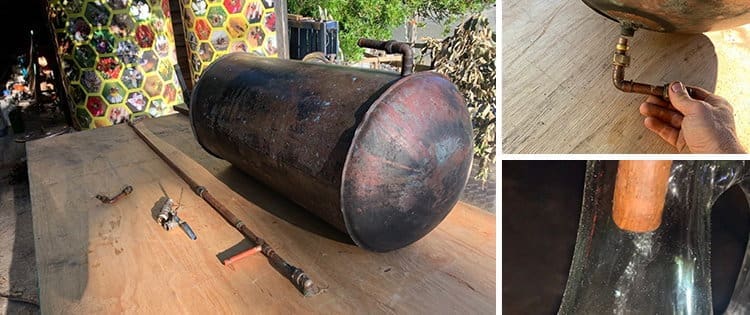









interesting, i like it
I tried to make a pdf file of your instructions for the distiller but unfortunately all the side advertising, cookie questions, facebook and twitter logos over write your instructions; thereby making them useless.
Hi W.B. Homer,
There is a “Print” button right at the end of the article, in the left section (right under “8 Easy Projects You Shouldn’t Miss From Your Backyard”). It saves the article in a pdf file. You can save the article like this.
Let me know if you need further assistance!
Hi Andy, thank you for the positive feedback.